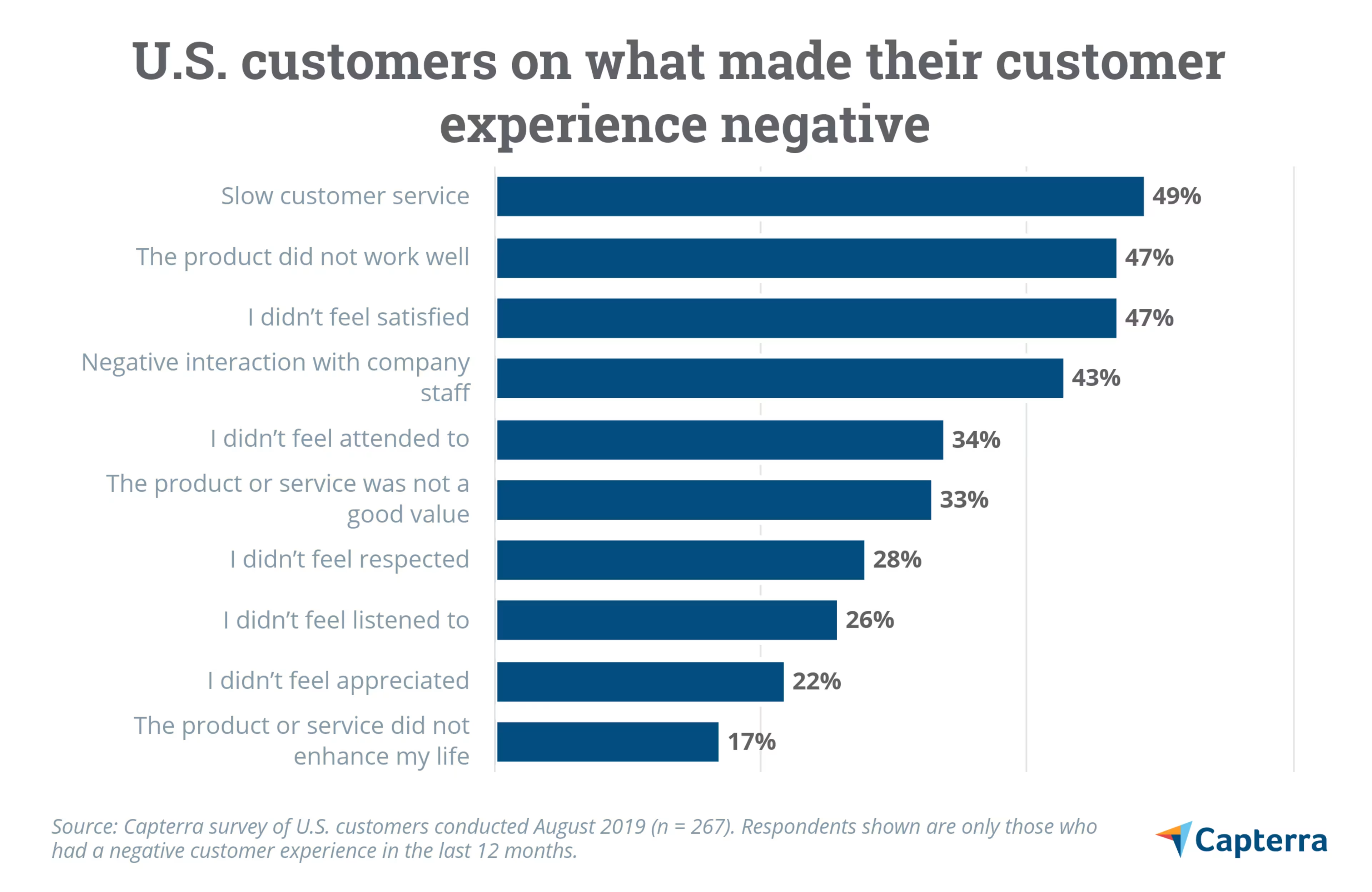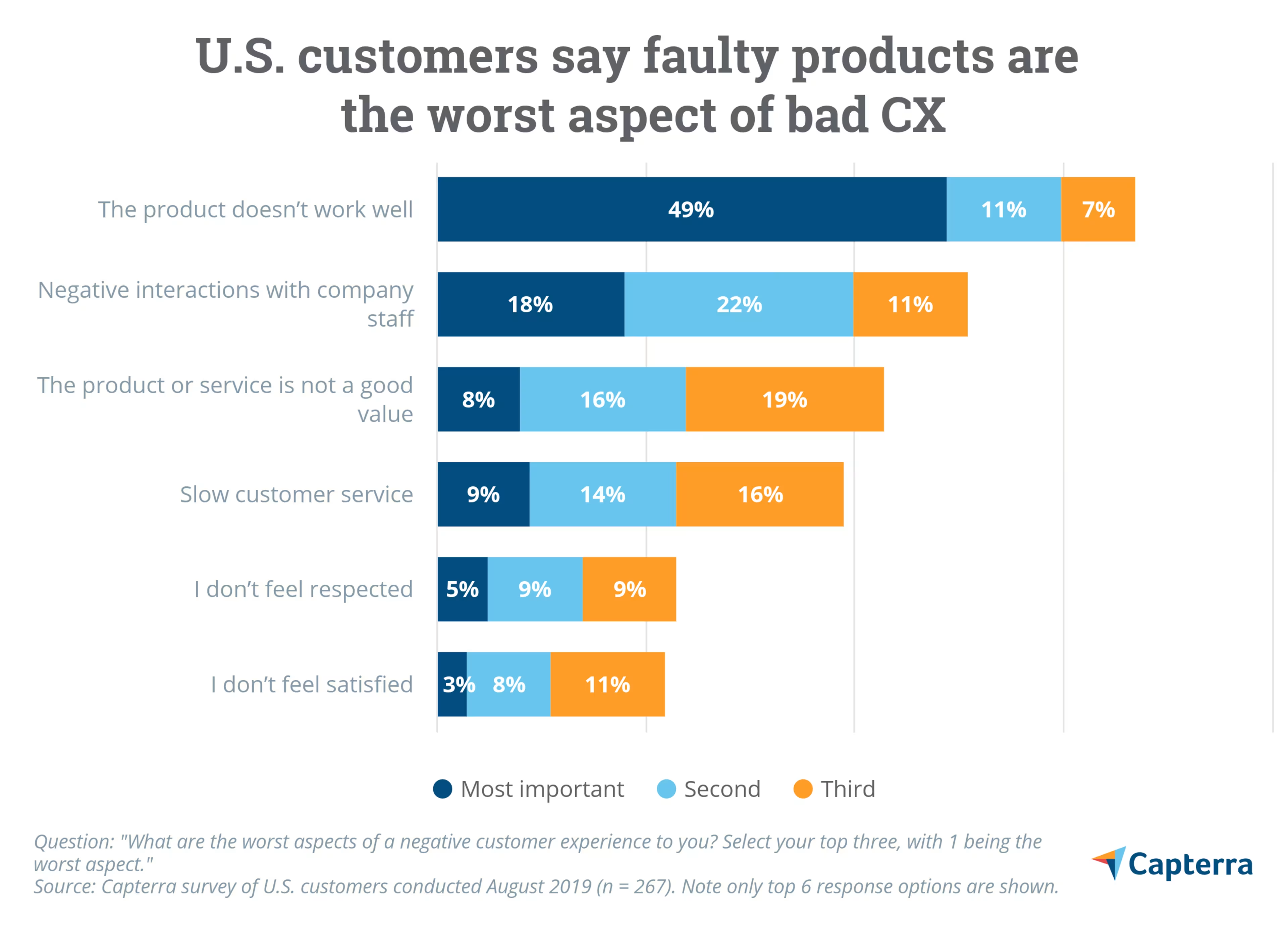Customer experience professionals can't solve customer problems without knowing what they are.

All businesses like to imagine their customers are having pain-free experiences. But sadly, that's not the reality.
About half (45%) of U.S. customers say they had at least one negative customer experience (CX) in the past 12 months, according to a recent Capterra survey.
To diagnose your customers' pain points—which can cause those negative experiences—you need to listen to them. Conduct surveys or other customer listening research. Think of customer feedback as a stethoscope, allowing you to listen in to the heart of your customers' experience.
In this article, we'll cover the results of our recent survey to provide guidance on common pain points and what you can do about them. Use these as a jumping-off point for your own research to make sure you're not a source of these customer pain points.
Top 3 customer pain points and how to address them
We recently surveyed U.S. customers who made an in-store or online purchase in the past 12 months and asked them two questions about their pain points. We asked them to check all aspects that made a customer experience negative and to rank their top three worst aspects of a negative customer experience.
A clear pattern emerged. In both questions, the following customer pain points were the most frequent complaints:
Slow customer service
The product did not work well
Negative interactions with company staff
We'll dig into the data on each of these pain points, and help you investigate whether this is a problem in your organization. We'll also give you suggestions for how to solve these problems, should you discover one is also an issue for your customers.
If you don't think any of these are problems at your organization, keep reading: Many of the investigation and problem-solving strategies can be applied to other issues as well.
1. Slow customer service
Among customers who had a negative CX in the past year, about half (49%) cite slow customer service as a reason for their sub-par encounter.
Slow customer service was also mentioned by about four in 10 (39%) respondents when asked to rank the worst aspects of a negative CX, including 9% who say this is their number one worst aspect of a bad customer experience.

Clearly, slow customer service is a major pain point for customers. But how can you know if this is a problem in your organization? And if it is, how should you address it?
How to check for this problem in your organization:
Use survey software to survey customers after they've completed a customer service interaction. Ask how satisfied they were with the overall service experience and how long it took to get their problem resolved.
Use customer service software to track team performance and speed.
Conduct an audit of customer service interactions and resolution times to look for problem areas and establish a baseline for future improvement efforts.
How to address the problem:
Use the results of your post-interaction customer surveys and service audit to identify specific issues creating or contributing to slow service.
Survey your employees to learn what might be hindering their service efficiency.
If you're not already using these tools, consider faster service options, such as self-service knowledge management software, chatbots, or live chat.
2. The product doesn't work well
Nearly half (47%) of customers who had a negative CX cite the product not working well as a reason.
When asked to rank the worst aspects of a negative CX, 67% listed the product not working well as their first, second, or third largest complaint. This includes a whopping 49% who list product issues as their number one complaint, by far the highest share for number one worst aspects in our survey.

How to check for this problem in your organization:
Conduct customer surveys a couple months after purchase to identify particularly salient issues.
Consider user experience (UX) research for your products. Ideally this would have taken place before your product hit the market, but if you're getting product complaints, then it's time to start or revisit UX research.
Use reputation management software to monitor reviews and/or social media for customer complaints about your products.
How to address the problem:
Work with stakeholders from any relevant departments who can provide insight on the issue (e.g. supply chain, manufacturing, product design, etc.).
Loop in or contract UX designers to help improve your product.
3. Negative interactions with company staff
About four in 10 (43%) U.S. customers say negative interactions with company staff are a key reason why they had a negative customer experience in the past year.
And when asked to rank the worst aspects of a negative CX, about half (51%) cited negative interactions with company staff as a top three complaint. This includes nearly one in five (18%) who say this is their number one CX complaint.
How to check for this problem in your organization:
Use survey software to survey customers after they've completed an in-store purchase or customer service interaction.
Consider using mystery shoppers to audit in-store interactions and evaluate the service they.
Use reputation management software to monitor reviews and/or social media for customer complaints about staff interactions.
How to address the problem:
Create or reevaluate staff training to ensure customers are receiving a consistently positive experience from all employees.
Work on improving the employee experience—happier employees results in happier customers.
If you're not already using these tools, consider service options for customers who prefer not to interact directly with other people, such as self-service or chatbots.
Consider software solutions to ease customer pain points
The above recommendations on how to check for problems in your organization, as well as how to solve them, are not a hard and fast checklist. Feel free to follow the steps that make the most sense for your organization.
There are several software solutions mentioned above that can help your organization solve these top three customer pain points, many of which are narrowly focused on a specific issue. For a broader solution, consider customer experience software. CX solutions are built to identify pain points throughout the customer journey, giving your organization a constant pulse on customer issues to solve before they become major problems.